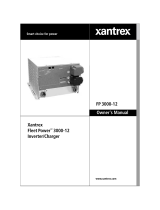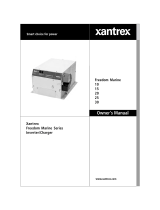
INSTALLATION REV 01-09-2021
Curtis Concerto Installation Manual
page 2
C) ADJUSTMENT TO MAINS VOLTAGE
During installation, or after changing installation site, it is advisable to check the actual value of the
mains voltage present at the installation site of the charger. If it is too high or too low compared to the
rated values, problems due to drops or increases in the charging current might arise.
The charger is usually pre-set for a 420V AC ± 5% or a 240V AC ± 5% mains voltage. Check mains
voltage and, if required, adjust the connection of mains voltage to the transformer by means of the
adjusting terminal board on the transformer. The above adjustment has to be performed by skilled
personnel only.
D) CONNECTION TO BATTERY
We advise the use of bipolar standard connectors which do not allow reverse polarity on battery.
Check also cable connection in the connector contacts.
The above check has to be performed by skilled personnel only.
E) CHARGING PROCESS (standard configuration)
· Once mains and battery connections have been performed, the card performs a lighting test of
all LED’s. Then the green “BATTERY CONNECTED” LED remains lit (constant).
· In the standard configuration the “AUTOSTART” function is enabled (as default setting): the
charger begins automatically charging 5 seconds after connection to battery. The Autostart stage is
indicated by the blinking of the green “END OF CHARGING” LED, red “SAFETY TIMER” LED,
and yellow “EQUALIZING CHARGE” LED.
· If the Autostart function is disabled, press the GREEN button to start the charging process. The
green LED (“CHARGING”) begins blinking, and it will blink for the whole charging process. To
stop charging, press the GREEN button again.
· After the initial charge stage, depending on the discharge rate of the battery, and provided that the
average cell voltage has reached 2.4 V/cell (adjustable value), the yellow “FINAL CHARGE” LED
will light up on the front control panel. Then an electronic timer starts counting down the last three
hours of final charge.
· When the final charge time (adjustable value) has elapsed, the charger stops automatically and the
green “END OF CHARGING” LED lights up.
· If the operator disconnects charger from battery during a charging process, the battery charger
stops temporarily the charging process and signals a fault by means of the yellow LD4 LED
blinking. On connecting again a battery to the charger, the card resets and starts the charging
process again. If the same battery is connected again to the charger, the charger will disregard any
final charge, which it might have begun previously (beginning from SW 2.1b)
F) EQUALIZING CHARGE
· The equalizing charge (see the corresponding yellow LED always lit) is an optional function with a
default factory setting. To disable it, contact the service engineers.
· The equalizing charge will start automatically after each normal charging cycle, but it can also
be deactivated by software (see the functions of the SW1 DIP switches).
· After the normal charge a pause will take place (T. Pause = 60 min) after which Equalizing will be
performed (for a Teq time = 45 h).
· Equalizing is made up of an Np amount (= 3) of Neq (= 5) pulse packages, each of which consists
of charges (T.ON = 12 min) and pauses (T. OFF = 48 min).
· The above mentioned pulse packages alternate with pauses (Ts = 15h).
· These pulses are performed during the Active cycle (=45h), followed by a Stop cycle (=120h).
· This equalizing system has no time limits and stops on battery disconnection. The system is very
useful during holidays and week-ends, since it makes it possible to keep battery charged while
preventing overcharging, overheating, and/or water consumption.
· This equalizing system has no time limits and stops on battery disconnection. The system is very
useful during holidays and week-ends, since it makes it possible to keep battery charged while
preventing overcharging, overheating, and/or water consumption.














